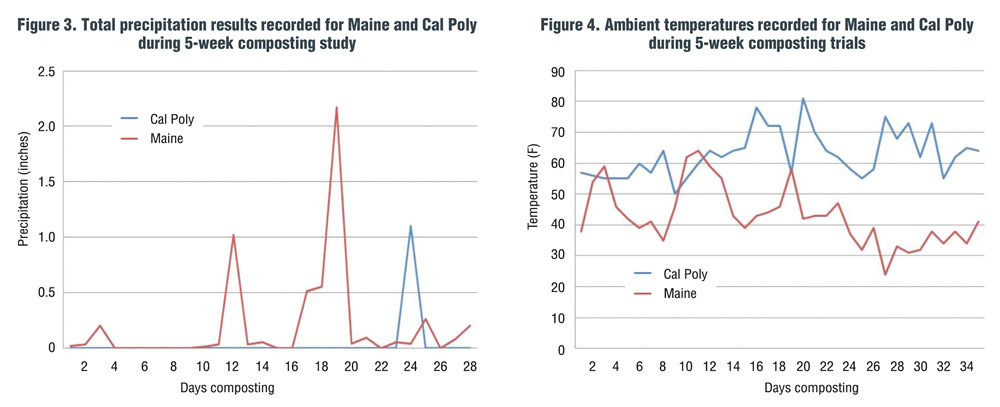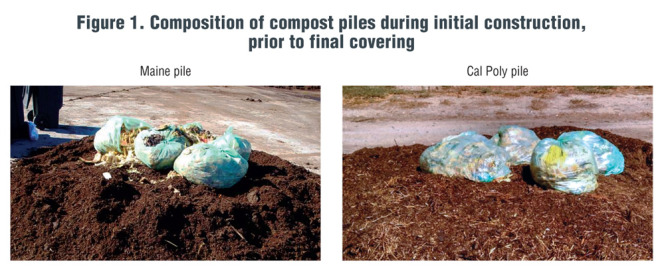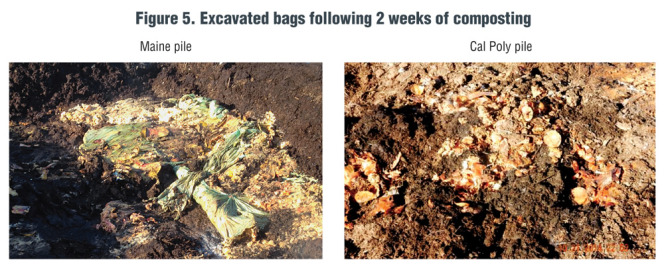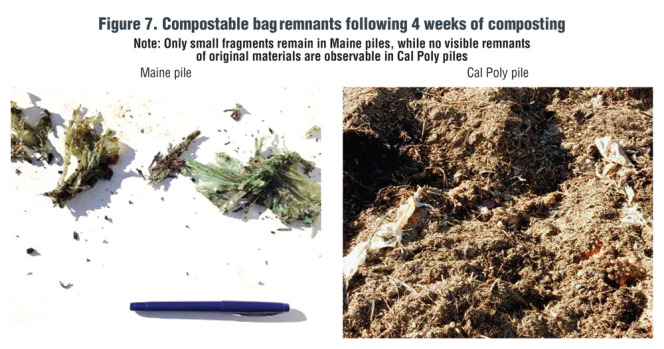Two simultaneous compostable bag trials were conducted in two different climates utilizing similar feedstocks and composting method.
M.A. King, K.L. Piper, G. MacDonald, S.E. Sherman, H. Francis, C.J. Hopkins and M.S. Clark
BioCycle January 2015
Numerous studies have evaluated compostable bag degradation based on composting temperatures, airflow and microbial activity [Chapman (1999), Kaiser (2001), Foster (2002), Scott (2008), and King et al. (2013)]. The current study attempts to examine the role moisture may play in the relative degradability of a commercially available compostable bag (BioBag™).
For this study, the authors — research teams from the Maine Department of Environmental Protection (MEDEP) and California Polytechnic State University (Cal Poly) — chose to use similar amounts of collected food, compost feedstock recipes and composting processes with the only differing component being a comparison of composting in two dramatically different composting climates — central Maine and the central coast of California. The study took place over a 5-week period.
Materials And Methods
Between October 6, 2014 and November 9, 2014, two simultaneous compostable bag trials were conducted, one at Rainbow Valley Farms in Sidney, Maine and the other at the College of Agriculture, Food and Environmental Sciences’ Compost Facility at Cal Poly in San Luis Obispo, California. Each trial began with a set of two piles, each measuring 6 to 7 cubic yards (cy) in volume and consisting of similar recipes with the following optimal characteristics being targeted at the outset: Carbon to Nitrogen Ratio (C:N)=29:1, %Moisture=55-59, and Bulk Density= 680-700 lbs/cy. Both Maine piles were constructed on October 6, 2014, using the following recipe: one part waste animal feed (hay and corn silage mix), one part bedded cow manure and two parts bedded horse manure. The Cal Poly piles were constructed over two consecutive days (October 7-8) and consisted of one part silage, one part dry manure, two parts horse manure and one part wood chips. During the initial construction, each pile (at both locations) began with an 8-foot wide by 8-foot long by 24-inch thick bed of the compost mixture. A total of 5 BioBags, containing approximately 420 lbs of food scraps were placed on top of the 24-inch base on each of the trial piles (Figure 1). Piles at both research sites were turned using a farm tractor bucket to keep turning similar.
Due to the very dry conditions at the Cal Poly site, an additional 100 gallons of water were initially added to each of their trial piles. Finally, each pile was capped with an additional 36-inch thick layer of compost mixture and allowed to precondition for two weeks to help initiate active composting. Daily temperatures were recorded using two Reotemp® analog thermometer probes (300 series) placed into each pile at 1-foot and 3-foot depths, allowing monitoring of biological activity near the surface and at the core of each pile.
Following the initial two-week “preconditioning period,” each pile was uncovered and visual observations were made to determine the approximate percentage of bag degradation. Each pile was remixed, and then reformed. Composting continued for a final two-week period and then the piles were opened again to determine the final percentage of bag degradation.
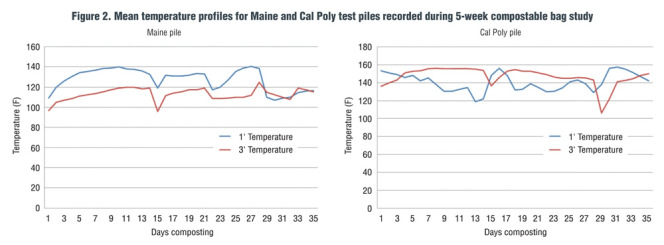
Figure 2. Mean temperature profiles for Maine and Cal Poly test piles recorded during 5-week compostable bag study
Results And Discussion
Pile Performance
Figure 2 portrays the mean distribution of temperatures for each of the trials during the 5-week study period. Both Maine and Cal Poly piles achieved periods of thermophilic composting temperatures (in excess of 131°F) during the 5-week period. The Cal Poly piles maintained consistently higher temperature profiles at both the 1-foot and 3-foot depths throughout the entire course of the study.
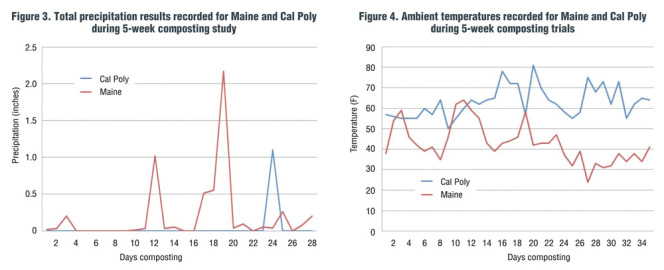
Figure 3. Total precipitation results recorded for Maine and Cal Poly during 5-week composting study
Figure 4. Ambient temperatures recorded for Maine and Cal Poly during 5-week composting trials
Part of the reason for the poorer performance of the Maine piles may be attributable to two factors: high amounts of precipitation received throughout the 5-week study, coupled with Maine’s cooler temperatures. During the study, the Maine site recorded 7.63 inches of precipitation, whereas the Cal Poly site recorded only 1.1 inches (Figure 3).
Additionally, Maine’s ambient temperature profile remained consistently cooler (with a few minor exceptions) than the Cal Poly site throughout the entire study (Figure 4). Collectively, the precipitation and cooler ambient temperatures had a cumulative effect on the relatively small pile sizes (6-7 cy in size), resulting in saturated piles, clogged pore spaces, and relatively cooler overall temperatures.
The Cal Poly piles demonstrated the opposite effect, due to excessive drying presumably from wind and very dry site conditions. What is interesting to note from the Cal Poly piles is the apparent shift in the direction of microbial activity very early in the process (Figure 2). At the outset, when the piles were initially constructed, there was an optimal balance of moisture throughout the piles. This was reflected in the temperature profile showing increased activity at the 1-foot level that is considered the most aerobic zone. However, after three days of composting activity, there is a noticeable decline in activity at the 1-foot level, followed by a steady increase in activity at the 3-foot level.
This shift reflects the possible drying effects of warmer temperatures and steady winds experienced at the Cal Poly site. The core, relatively protected from these factors, shows increased microbial activity as the moisture from the food scraps is continually released. Upon the first turning, there is once again a resurgence in temperature at the 1-foot level and then another decline occurs. Finally, during the second turning on week four, an additional 100 gallons of water are added to each pile, resulting in another surge at the one-foot level (Figure 2), which again began to decline within 4 to 5 days.
Compostable Bag Degradation
Compostable bag breakdown was monitored over the course of the 5-week study and was noted and recorded at each pile turning. The first examination was conducted at both sites following the 2-week preconditioning period (Figure 5). Excavation of the Cal Poly piles showed a moist core with significant degradation of both the food scraps (~80% degraded) and the BioBags (~85% degraded). The investigators surmised that the food scraps were providing sufficient moisture to the piles, so no additional water was added prior to reforming the piles the first time.
In contrast, excavation of the Maine piles after the 2-week period revealed a saturated, odorous, anaerobic core. Only a small percentage (~20%) of the food scraps and BioBags had shown any significant breakdown. Based on this observation, a decision was made to open and thoroughly mix the piles more frequently (every week) for the remainder of the study in an effort to promote aerobic composting. When the Maine piles were opened again at the end of Week 3, there was a saturated core and ~60 percent degradation of the BioBags (Figure 6).
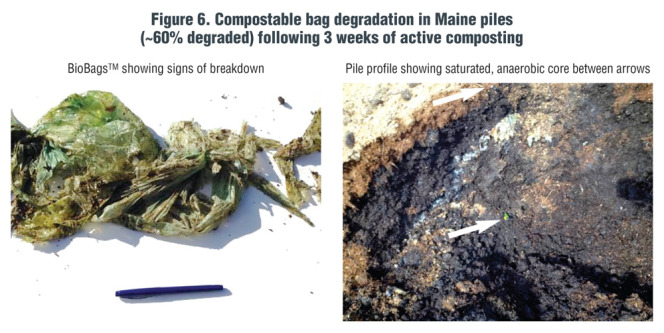
Figure 6. Compostable bag degradation in Maine piles
(~60% degraded) following 3 weeks of active composting
Week 4 demonstrated significant degradation at both study sites (Figure 7). Pile excavations at Cal Poly showed ~90 to 95 percent degradation of both the food scraps and BioBags. Similarly, the Maine piles showed ~85 percent reduction in the food scraps and BioBags, although wet, anaerobic pockets containing whole food were still noticeable.
A final excavation was conducted on the Maine piles during Week 5. The piles were still saturated at the core, but only a small handful of BioBag fragments remained, leading the researchers to determine that over 90 percent had been degraded.
Conclusions
The results from this 5-week study indicate that moisture serves as a key limiting factor in not only the composting process, but also in compostable bag degradation. Even with the moisture challenges, both study sites were able to show greater than 90 percent degradation of the compostable bags within a 5-week period. Madejon et al. (2002) reported that the optimum moisture content is a delicate balance between the moisture needs of microbial metabolism and the need for adequate oxygen levels. Richard et al. (2002) further defined the optimum moisture level for enhanced decomposition to be a range between 50 percent up to 74 percent on a wet basis. In the case of the current study, the Maine piles contained a moisture content that appeared to be in excess of 74 percent, especially within the pile core, resulting in the filling of available pore spaces leading to greatly inhibited microbial activity.
Additionally, the composting processes used by both sites did not provide for homogeneous blending and thus, the anaerobic pockets experienced in the Maine trials were somewhat unavoidable. The use of a mechanized turner or commercial mixer during initial pile construction would have allowed for a more thorough mix to help facilitate aerobic composting. Additionally, use of commercially available compost covers (such as, Compostex™ or Gore™) would help promote aerobic composting conditions by preventing excessive moisture accumulation from subsequent precipitation events. The use of compost covers would have also benefited the Cal Poly study site by preventing the evaporative losses caused by warmer temperatures and drying effects of the wind.
Mark. A. King, George MacDonald, Carla J. Hopkins and Michael S. Clark are with the Maine Department of Environmental Protection in Augusta, Maine. Kevin L. Piper, Steven E. Sherman and Hunter Francis are with the College of Agriculture, Food and Environmental Sciences at California Polytechnic State University in San Luis Obispo, California.
Acknowledgements
The authors wish to extend our thanks to Harland Bragg of Rainbow Valley Farm, Sidney, Maine and to the College of Agriculture, Food and Environmental Sciences California Polytechnic State University, San Luis Obispo, California for their generous support of this research effort.


